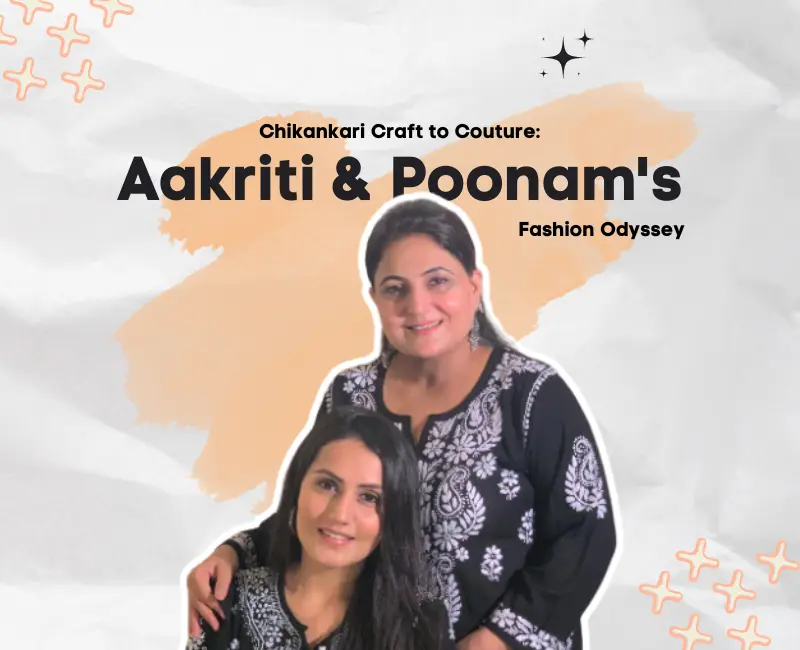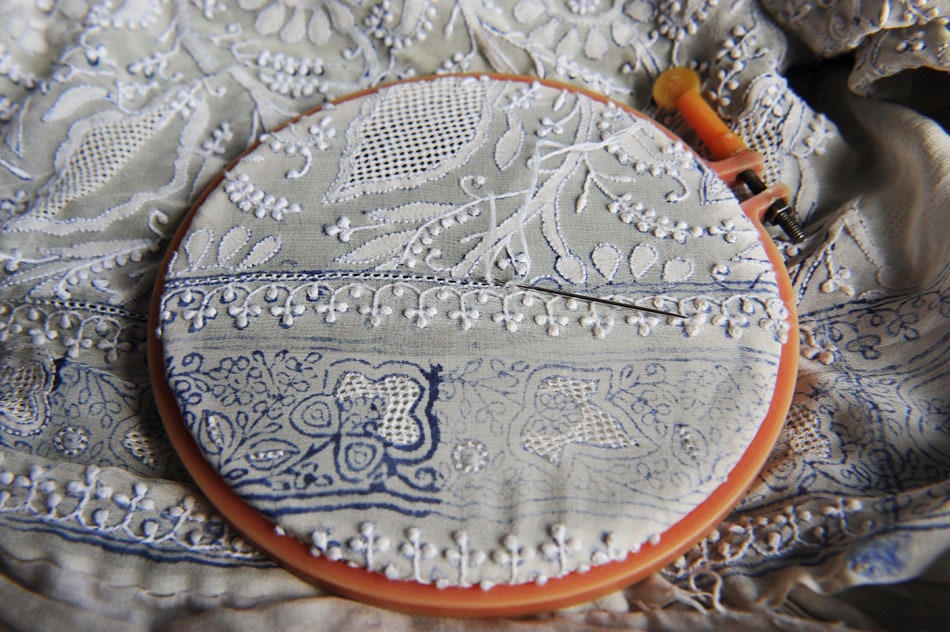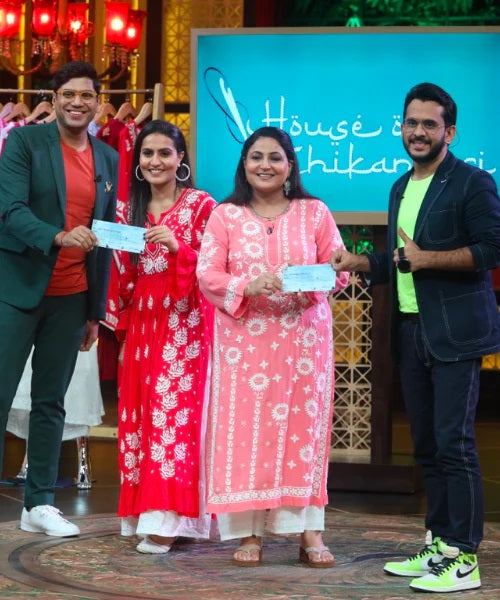Chikankari Craft to Couture: Aakriti and Poonam’s Fashion Odyssey

Amidst this historic city of Lucknow, which boasts of unsung lanes and crowded markets that still bear the memories of a glorious past, there are two women who are pioneering a change in one of India’s most endearing artisanal craft. Aakriti and Poonam Rawal, the masterminds of the House of Chikankari, have begun an unprecedented mission to transform Chikankari from a local embroidery to an international luxury fabric. This mother-daughter duo carved out a niche of dying culture and tradition to make Chikankari accessible to the younger generation. In 2020, amidst the lockdown they decided to uplift artisans with hand-made, authentic Chikankari outfits.
The Roots of Chikankari
Chikankari is a traditional white work embroidery technique and has been a part of the culture of Lucknow since the Mughal Era. Considered to date back to early the seventeenth century and to have been practiced by Nur Jehan, wife of Mughal Emperor Jahangir, this craft has endured the vicissitudes of time, the royal patronage, the colonial period, and the modern post-independence Era.

The charm of Chikankari therefore does not lie in gaudiness but in finesse. They are intricate and delicate designs made on sheer fabrics, including cotton and muslin with a fine needle. The other general decorative motifs depicted in art class are those derived from Mughal architecture such as flower, vine and geometric motifs. The result is a fabric that appears to shimmer and change as it catches the light, creating an illusion of depth and texture.
However, the continued advancement in industrialization brought numerous challenges to Chikankari despite its inherent appeal. Fashion knockoffs, declining trends among young people, and stagnation in creativity would have seen this elegant art form pushed to the realms of history. It was in this backdrop that Aakriti along with Poonam Rawal who brought a refreshing change to Chikankari.
The Rawal Women: A Generational Legacy
Poonam Rawal, who is originally from Lucknow, was raised amidst the charming realm of Chikankari. She used to follow her mother to the local markets where she developed a fascination with the works of embroidery. These initial experiences shaped her love for the craft, a passion that she would inculcate in her daughter, Aakriti.
Growing up in a home that cherished the arts, Aakriti came naturally to embrace textiles and design. While doing her education in fashion design she came to realize the difference between traditional Indian craft and fashion. This spark of thought started during her college days when she realized that there is a need to close this gap and introduce Chikankari as a fashion fabric of the contemporary world.
The start of the House of Chikankari saw the coming together of two different generations where Poonam brought in her ancestral sensibilities of the craft and its relevance in the modern scenario while Aakriti brought in youth and the global fashion sensibilities. With this objective in mind, both of them embarked on a journey to reinvent Chikankari for the new millennium.

Challenges and Innovations
Speaking of the drift from craft to couture, the Rawal women encountered some challenges along the way. The first task was to persuade the traditional artisans to explore new designs and try something new on their creations. Many of these skilled craftspeople, having inherited their knowledge through generations, were initially resistant to change. Poonam’s approach was one of gentle persuasion. For months she explained to the artisans, listened to their opinions, occasionally discussed new ideas. Her polite and humble approach towards them and showing her belief on Embroidery Chikankari new form also helped in convincing them.

As for Aakriti, the goal was to bring in a contemporary approach to the aspect of design. She added modern elements to her motives, incorporated bright and rich colors to her works instead of using only white and tried new materials for her pieces. Her designs remained rooted in Chikankari but targeted a younger, fashion-conscious market.
One of the biggest changes that they brought in was the use of Chikankari on fabrics that were not conventionally used on. They went further and started using silk, organza and some synthetic fabrics that were available in the market. This not only opened up a wider market range for them but also pressed out more creativity to the artisans as they had to diversify towards other materials.
They also understood the significance of sustainability in the contemporary fashion world. They followed environmental conservation methods in their production, including dyeing techniques where they used natural dyes and encouraged the use of available materials. This commitment to sustainability was not only in tune with the international frameworks, but it also represented the very soul of the Chikankari craft as a low impact, handmade process.
From Bazaars to Fashion Show-Stages
In its initial stages, the House of Chikankari was focused on producing more handmade products to sell locally. In this case, Poonam and Aakriti would most likely have direct control over every aspect of production, from the initial idea of the design to the final inspection of the product. Gradually, their commitment to quality and excellence started finding customers outside the boundaries of Lucknow.
A major breakthrough came when they received an invitation to fashion a collection that would be exhibited in a regional fashion week. The use of fusion that includes Chikankari work on the ethnic as well as modern cuts appealed grabbed the attention of fashion critics and buyers. All of the sudden, the House of Chikankari was brought into the national limelight.
With increased popularity, the companies expanded their business too. A small-scale design workshop in Lucknow was later converted into a comprehensive design house. They started associating with other famous fashion designers and started designing Chikankari limited series for elite and celebrities.
They also invested in technology to streamline certain aspects of their operation. They
used a specially developed inventory tracking system to manage raw materials and finished goods on different sites. But they were very cautious to make certain that technology was integrated into their products without overshadowing the handmade aspect of their products.
Journey to Shark Tank
The growing popularity of the House of Chikankari at the national level did not go unnoticed by the producers of the famous reality show Shark Tank India Season 2, which invites business leaders to present their projects. For Aakriti and Poonam, this was an opportunity of a lifetime to take their brand to the national level and maybe source for funding to support the expansion.
The preparations for going on the shark tank show were rigorous. Both the mother and daughter rehearsed for weeks what they were going to say, analyzed all the financial numbers, and calculated what the Sharks might ask them. They realized they had to explain that chikankari was not just a lucrative business proposition, but something that held great cultural value.

On the day of the shoot, both Aakriti and Poonam were excited and nervous when they entered the Tank. Aakriti wore the garment that was designed by her – a Chikankari inspired blazer over palazzo pants and Poonam donned a conventional Chikankari saree with a quirky twist. Their pitch was compelling, and they received an offer from four out of five sharks. They finally secured the deal with 2 sharks, Mr. Aman Gupta, co-founder and CMO of boAT and Mr. Peyush Bansal, co-founder and CEO of Lenskart.
The Shark Tank appearance marked a new chapter for the House of Chikankari. The publicity from the show led to a surge in orders, and the investment allowed them to expedite their expansion plans. For Aakriti and Poonam, the Shark Tank experience was more than just a business deal. It was a platform to share their passion for Chikankari with the entire nation.
The Future of the House of Chikankari
Today the House of Chikankari is a testament to the uninterrupted vision for its revival, persistence and, finally, the reverence for tradition. Both Aakriti and Poonam have turned Chikankari from a regional handicraft product into an international brand of sophistication. It seems their journey has created new grounds for the young generation of designers to seek inspiration from the history of textile India. The success achieved by the House of Chikankari also means that other forms of handicrafts can also establish themselves in the international arena of Haute Couture. Regarding the future, Aakriti and Poonam are always seeking new ways of evolving the product. They are trying to incorporate Chikankari with new-age fashion technologies; they are trying new products and innovations in new fabrics which is a sustainable fashion, and they are going beyond the new norms.
Nonetheless, there is one constant at the core of their endeavors, and that is a tangible appreciation of the discipline, as well as the master’s behind it. As Poonam often says, “Every stitch tells a story – of our heritage, our artisans, and our journey from a small workshop to the global stage.”
Conclusion
Aakriti and Poonam Rawal’s story is not merely of the success of an organization, but of a dream becoming reality. This is the story of culture, people and their existence, and a sacred balance between the past and future. They have not only put Chikankari on a new pedestal but also taught the world about the soul-stirring and timely essence of Indian textiles. As the fashion world continues to evolve, the House of Chikankari stands as a shining example of how ancient crafts can find new expressions in the modern world. Aakriti and Poonam’s fashion odyssey is far from over – it’s a continuing journey of discovery, innovation, and celebration of the exquisite art of Chikankari.


